Inside Darrell Holland's Long Range Shooting School
By Ernie Bishop
Like many, I had no mentor in the arena of long range shooting. I have learned what I know from this source or that source, and much through experiences and of course failure. One must be willing to fail, to succeed. Many are afraid to fail; hence they never try something new, and therefore do not learn. Since long range shooting from field positions is a niche sport, those who are equipped to mentor or teach newcomers to the sport are few and far between. Add to that equation the small amount of time these mentors have to share their knowledge, and we can see why many struggle when it comes to long range shooting.
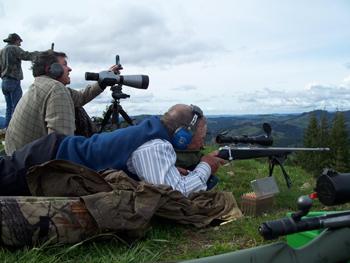
Photo taken by Steve Lovejoy
Because of the death of a long time friend who had helped Darrell Holland in all of his long range shooting schools, there was a void which needed to be filled. Darrell and I first "met" via phone, email, and the web when I was in the process of getting my center-grip 7mm Dakota XP-100 built by Kirby Allen. Kirby had recommended Holland's Quick Discharge for this specialty pistol. After that first phone call a friendship began to materialize. It was not until several years later that we would actually meet in April of 2009, in Powers, Oregon. Yes, I was in Oregon for the first time in my life to be an assistant teacher for Holland's Long Range Shooting School. Note: I am one of several assistants that help Darrell with the school.
Many of you know that I do not own a centerfire rifle, and that I use handguns (primarily specialty handguns) for almost all of my shooting or hunting. You may be wondering how a specialty pistol shooter can be of any benefit to rifle shooters. Honestly, there is not as much difference, as one may think. The biggest difference is the use of the rear bag on the pistol grip versus the bottom of the stock and the lack of a cheek weld. The mechanics of good shooting form, understanding and/or teaching about wind, ballistics, bullet selection, parallax adjustment, etc., is the same. Let me add here that I was a little apprehensive about helping students shoot a rifle better when I had not used one much in the last 20 years. What was comforting was that I can still shoot a rifle well, when I use one. Yes, I shot several rifles (Darrell's and students') at long range and they even took pictures for proof! I can also attest that I learned some important things about shooting a rifle that I did not know before my trip to Oregon.
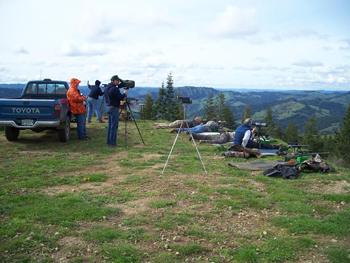
Photo taken by Steve Lovejoy
Having been a part of several long range shooting schools for specialty pistols, I was very impressed with the amount of information shared and the time shooting that could be accomplished in four days. The thing that stood out the most to me was the focus on building a good foundation. I have realized over the years, there are more hunters than one could imagine that do not know how to zero their scope or clean and maintain their rifle adequately. Add to that the pride men tend to have when it comes to being taught things, such as proper shooting technique in the field. Since many have been pulling the trigger before they could talk, or have hunted around the world successfully, it takes some time to change bad habits that show up quickly at longer distances. While I was there, one of the students shot a rifle for the first time in their life. It caused me to truly appreciate the systems approach to accuracy in the field with an emphasis on the basics.
There is a combination of class time and field shooting each day. Every student is given a three-ring class notebook that is professionally done, and is full of useful information. Basically, it allows the student to have Darrell's PowerPoint presentation for their future use, once they go home. Both the notebook and the PowerPoint presentation are upgraded each year. Reading assignments and homework are given each night (100 proper bolt manipulations each night as an example), so don't assume you will have time to rent a DVD. The load for each rifle is chronographed and zeroed at 100 yards. A customized drop chart for each student is made from Holland's Ballistic Gold Card software for their rifle.
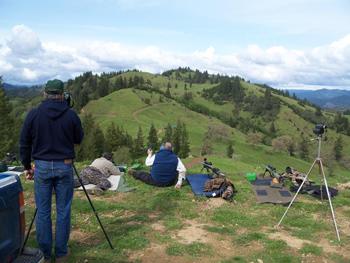
Photo taken by Steve Lovejoy
The shooting environment for the field shooting is beautiful to the eye. The lay of the land allows for up and down drafts, and every type of wind condition you can imagine, depending on the wind at the moment. Once guns are zeroed and drop charts made, each student begins to stretch things out distance-wise. The way the steel range is set up the student can proceed at their level and not be held back or pushed forward by other students. All shooting is done from the prone position. There is a portable shooting bench that can be used if there is a problem that does not allow the student to shoot from the prone position. A covered area is just behind the shooting area, where students have access to water, and is also the place where the guns are cleaned.
After a period of time, students pair up and take turns spotting and calling wind while the other is shooting. With everything that is done, whether in the classroom or the range, the instructors are watching, giving counsel or answering questions. There is individual time spent with each student, helping them improve from where they started. It was pleasing to watch students grow in their understanding and shooting skills.
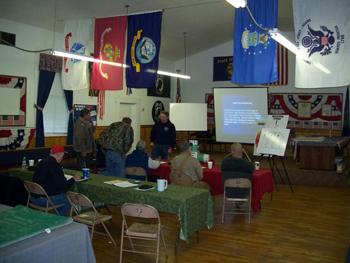
Photo taken by Steve Lovejoy
When you come to Holland's Long Range Shooting School you will notice quickly the commitment for each shooter to be able to make a perfect shot under duress from field positions. When hunting or if you are in a field or tactical match, the ability to shoot well when tired or emotionally stressed is paramount.
To be able to shoot consistently you must have correct shooting form that does not add stress or muscle fatigue.
Some Topics Stressed During The Four Day School:
Proper placement of the butt stock into the shoulder pocket, a light but firm grip on the rifle, (no death grips) with the tip of the trigger finger compressing the trigger in a straight line thru the rifle to the shoulder pocket is emphasized.
The rifle stock should provide a proper "stock weld" allowing the shooter to have a full field of view thru the scope. Stock weld is a necessity that many overlook for solid field shooting.
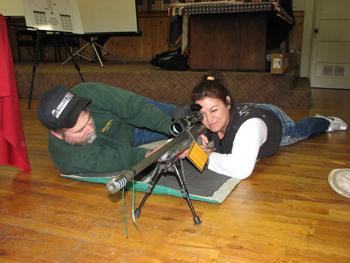
Accurate sight alignment and focus on the target are keys to success as well. As a side note, often shooters will allow their rifle to "buffalo" them by recoil, noise or a combination of the two. I have seen grown men flinch, treat the trigger as if it burned their finger, shut their eyes or even turning their face away from the rifle, when shooting or preparing to shoot. It does not take a rocket scientist to know that the ability to shoot accurately will be greatly hindered if one is reacting in these ways while attempting to shoot.
The aiming point (reticle) must be on the exact spot we wish to hit and our focus on that spot is so intense that it completely crowds out any other thoughts about noise and recoil. Instead of attempting to tell yourself not to flinch, focus on the very thing that will cause you to shoot better. Sound easy? It may not be as easy to break old habits as we think, but with time and proper practice you will become a better shot.
Flinching
Correct breathing and focus when shooting will help you defeat the embarrassing disease of "flinchitis." There is great attention placed on the importance of shot execution and breathing. Shooting small groups on paper or in the field is all about consistency, which becomes part of the shooting ritual. This also applies to breathing practice when shooting. Breathing during the shot, holding our breath the next, and shooting on empty lungs will all change point of impact.
Darrell believes that about 90% of the shooters that have gone through the school have a flinch of one degree or another and the brain simply overrides or interrupts the shot process by reminding the shooter about the recoil, noise, and or pain he is about to experience by squeezing the trigger. When one does not have proper focus, the result is a flinch of some kind and a less than perfect shot. Sadly, this becomes a habit as the mind and the body remembers the experience.
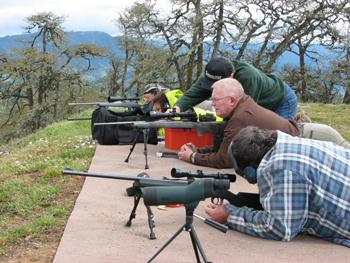
The Holland Long Range Shooting School teaches a proprietary technique of shot control that has produced exceptional results from the students. It is based on the belief that we can only process one conscious thought at a time and in order to undo the conditioned response of flinching we must give the brain something else to focus on. Much easier said than done, however if we give the brain something else to focus on we can be more successful. With proper hold and sight alignment we must intentionally focus on our aiming point. Inhale (oxygenating the brain) and begin the exhale process. When we reach our "Natural Respiratory Pause," this is the subconscious mind's signal to compress the trigger while we maintain our intense focus on the target. We must not allow the brain to intervene or distract us from that focus. If the brain gains control over the shot, we must start the process over.
Another aspect of shooting that can be easily overlooked is good follow through. Depending on the caliber and bullet you are shooting, after the trigger is tripped, the bullet will remain in the barrel for approximately .024 seconds and the rifle will recoil something like 3/8 of an inch. It is crucial that the shooter keep consistent control or tracking of the rifle during this time frame. The rifle must recoil uninterrupted for 3/8 of an inch for the shot to be good. If the shooter flinches, bi-pod recoils over a rock, or if one is using the rear bag improperly this can cause poorly placed shot. Smooth uninterrupted tracking of the rifle from ignition to impact is essential for accurate long-range shooting.
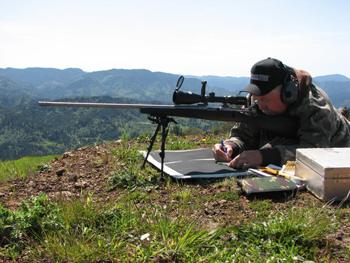
Bolt manipulation skills were an area I really enjoyed watching Darrell teach. His style is smooth, fast, and your head never leaves the stock. This is important in hunting because the animal does not always drop immediately, and a second shot may be required. When engaging multiple targets, proper bolt manipulation is the edge you want if you are competing or if your work requires you to protect others.
You will walk away with a good understanding of the Milliradian and Minute of Angle and will be able to reticle-range targets with your scope. The wind may not be your friend, but you will be given the tools to better understand it and to be able to dope it correctly. The student is also given a basic understanding of how bullet flight is affected by temperature, shooting at up/down angles, barometric pressure, and altitude. These concepts are all taken into consideration in a simple easy to understand way. Besides being presented with all the good information, you will also get to put the principles into practice. In so doing, you will enjoy the beautiful sound of your bullet ringing steel, and it will be music to your ears.
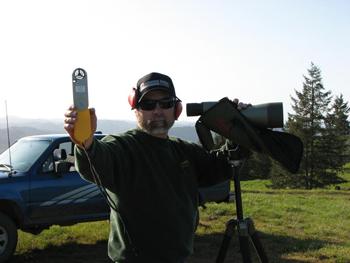
One cannot consider long range hunting without spending some time covering hunting ethics. Each student is encouraged to know their limitations with equipment, skill levels, and the conditions they find themselves in. There is a good amount of humor and hunting wisdom thrown in with stories to keep things interesting.
Coffee is always available in the classroom for those who need to hook up to the caffeine intravenously via the coffee cup. Lunch is eaten together as a group and is very enjoyable, both for the food and fellowship. There was always a spirit of teamwork and mutual encouragement in the two schools I helped with. You will make new friends, get to see and shoot some nice rigs, and have a lot of fun.
Darrell has a servant heart and gives himself completely to his students. I highly recommend Holland's Long Range Shooting School. If you want to improve your long range shooting skills in the field for when that moment of truth comes, I would encourage you to give Darrell a call (541) 439-5155 or check out his website: http://www.hollandguns.com
When I asked him if he would be willing to open his school for specialty handgun shooters when I was there, his response was, "Yes!" Now, if I can get him to shoot a specialty pistol at long-range. Actually, he did this past spring and made a great 600-yard shot...of course!
Ernie Bishop resides in Gillette, Wyoming, where he serves as a preacher. He enjoys long range hunting for varmints and big game with handguns. Ernie also uses his specialty handguns in tactical style matches and in 1,000 yard competitions once or twice a year.
By Ernie Bishop
Like many, I had no mentor in the arena of long range shooting. I have learned what I know from this source or that source, and much through experiences and of course failure. One must be willing to fail, to succeed. Many are afraid to fail; hence they never try something new, and therefore do not learn. Since long range shooting from field positions is a niche sport, those who are equipped to mentor or teach newcomers to the sport are few and far between. Add to that equation the small amount of time these mentors have to share their knowledge, and we can see why many struggle when it comes to long range shooting.

Photo taken by Steve Lovejoy
Because of the death of a long time friend who had helped Darrell Holland in all of his long range shooting schools, there was a void which needed to be filled. Darrell and I first "met" via phone, email, and the web when I was in the process of getting my center-grip 7mm Dakota XP-100 built by Kirby Allen. Kirby had recommended Holland's Quick Discharge for this specialty pistol. After that first phone call a friendship began to materialize. It was not until several years later that we would actually meet in April of 2009, in Powers, Oregon. Yes, I was in Oregon for the first time in my life to be an assistant teacher for Holland's Long Range Shooting School. Note: I am one of several assistants that help Darrell with the school.
Many of you know that I do not own a centerfire rifle, and that I use handguns (primarily specialty handguns) for almost all of my shooting or hunting. You may be wondering how a specialty pistol shooter can be of any benefit to rifle shooters. Honestly, there is not as much difference, as one may think. The biggest difference is the use of the rear bag on the pistol grip versus the bottom of the stock and the lack of a cheek weld. The mechanics of good shooting form, understanding and/or teaching about wind, ballistics, bullet selection, parallax adjustment, etc., is the same. Let me add here that I was a little apprehensive about helping students shoot a rifle better when I had not used one much in the last 20 years. What was comforting was that I can still shoot a rifle well, when I use one. Yes, I shot several rifles (Darrell's and students') at long range and they even took pictures for proof! I can also attest that I learned some important things about shooting a rifle that I did not know before my trip to Oregon.

Photo taken by Steve Lovejoy
Having been a part of several long range shooting schools for specialty pistols, I was very impressed with the amount of information shared and the time shooting that could be accomplished in four days. The thing that stood out the most to me was the focus on building a good foundation. I have realized over the years, there are more hunters than one could imagine that do not know how to zero their scope or clean and maintain their rifle adequately. Add to that the pride men tend to have when it comes to being taught things, such as proper shooting technique in the field. Since many have been pulling the trigger before they could talk, or have hunted around the world successfully, it takes some time to change bad habits that show up quickly at longer distances. While I was there, one of the students shot a rifle for the first time in their life. It caused me to truly appreciate the systems approach to accuracy in the field with an emphasis on the basics.
There is a combination of class time and field shooting each day. Every student is given a three-ring class notebook that is professionally done, and is full of useful information. Basically, it allows the student to have Darrell's PowerPoint presentation for their future use, once they go home. Both the notebook and the PowerPoint presentation are upgraded each year. Reading assignments and homework are given each night (100 proper bolt manipulations each night as an example), so don't assume you will have time to rent a DVD. The load for each rifle is chronographed and zeroed at 100 yards. A customized drop chart for each student is made from Holland's Ballistic Gold Card software for their rifle.

Photo taken by Steve Lovejoy
The shooting environment for the field shooting is beautiful to the eye. The lay of the land allows for up and down drafts, and every type of wind condition you can imagine, depending on the wind at the moment. Once guns are zeroed and drop charts made, each student begins to stretch things out distance-wise. The way the steel range is set up the student can proceed at their level and not be held back or pushed forward by other students. All shooting is done from the prone position. There is a portable shooting bench that can be used if there is a problem that does not allow the student to shoot from the prone position. A covered area is just behind the shooting area, where students have access to water, and is also the place where the guns are cleaned.
After a period of time, students pair up and take turns spotting and calling wind while the other is shooting. With everything that is done, whether in the classroom or the range, the instructors are watching, giving counsel or answering questions. There is individual time spent with each student, helping them improve from where they started. It was pleasing to watch students grow in their understanding and shooting skills.

Photo taken by Steve Lovejoy
When you come to Holland's Long Range Shooting School you will notice quickly the commitment for each shooter to be able to make a perfect shot under duress from field positions. When hunting or if you are in a field or tactical match, the ability to shoot well when tired or emotionally stressed is paramount.
To be able to shoot consistently you must have correct shooting form that does not add stress or muscle fatigue.
Some Topics Stressed During The Four Day School:
Proper placement of the butt stock into the shoulder pocket, a light but firm grip on the rifle, (no death grips) with the tip of the trigger finger compressing the trigger in a straight line thru the rifle to the shoulder pocket is emphasized.
The rifle stock should provide a proper "stock weld" allowing the shooter to have a full field of view thru the scope. Stock weld is a necessity that many overlook for solid field shooting.

Accurate sight alignment and focus on the target are keys to success as well. As a side note, often shooters will allow their rifle to "buffalo" them by recoil, noise or a combination of the two. I have seen grown men flinch, treat the trigger as if it burned their finger, shut their eyes or even turning their face away from the rifle, when shooting or preparing to shoot. It does not take a rocket scientist to know that the ability to shoot accurately will be greatly hindered if one is reacting in these ways while attempting to shoot.
The aiming point (reticle) must be on the exact spot we wish to hit and our focus on that spot is so intense that it completely crowds out any other thoughts about noise and recoil. Instead of attempting to tell yourself not to flinch, focus on the very thing that will cause you to shoot better. Sound easy? It may not be as easy to break old habits as we think, but with time and proper practice you will become a better shot.
Flinching
Correct breathing and focus when shooting will help you defeat the embarrassing disease of "flinchitis." There is great attention placed on the importance of shot execution and breathing. Shooting small groups on paper or in the field is all about consistency, which becomes part of the shooting ritual. This also applies to breathing practice when shooting. Breathing during the shot, holding our breath the next, and shooting on empty lungs will all change point of impact.
Darrell believes that about 90% of the shooters that have gone through the school have a flinch of one degree or another and the brain simply overrides or interrupts the shot process by reminding the shooter about the recoil, noise, and or pain he is about to experience by squeezing the trigger. When one does not have proper focus, the result is a flinch of some kind and a less than perfect shot. Sadly, this becomes a habit as the mind and the body remembers the experience.

The Holland Long Range Shooting School teaches a proprietary technique of shot control that has produced exceptional results from the students. It is based on the belief that we can only process one conscious thought at a time and in order to undo the conditioned response of flinching we must give the brain something else to focus on. Much easier said than done, however if we give the brain something else to focus on we can be more successful. With proper hold and sight alignment we must intentionally focus on our aiming point. Inhale (oxygenating the brain) and begin the exhale process. When we reach our "Natural Respiratory Pause," this is the subconscious mind's signal to compress the trigger while we maintain our intense focus on the target. We must not allow the brain to intervene or distract us from that focus. If the brain gains control over the shot, we must start the process over.
Another aspect of shooting that can be easily overlooked is good follow through. Depending on the caliber and bullet you are shooting, after the trigger is tripped, the bullet will remain in the barrel for approximately .024 seconds and the rifle will recoil something like 3/8 of an inch. It is crucial that the shooter keep consistent control or tracking of the rifle during this time frame. The rifle must recoil uninterrupted for 3/8 of an inch for the shot to be good. If the shooter flinches, bi-pod recoils over a rock, or if one is using the rear bag improperly this can cause poorly placed shot. Smooth uninterrupted tracking of the rifle from ignition to impact is essential for accurate long-range shooting.

Bolt manipulation skills were an area I really enjoyed watching Darrell teach. His style is smooth, fast, and your head never leaves the stock. This is important in hunting because the animal does not always drop immediately, and a second shot may be required. When engaging multiple targets, proper bolt manipulation is the edge you want if you are competing or if your work requires you to protect others.
You will walk away with a good understanding of the Milliradian and Minute of Angle and will be able to reticle-range targets with your scope. The wind may not be your friend, but you will be given the tools to better understand it and to be able to dope it correctly. The student is also given a basic understanding of how bullet flight is affected by temperature, shooting at up/down angles, barometric pressure, and altitude. These concepts are all taken into consideration in a simple easy to understand way. Besides being presented with all the good information, you will also get to put the principles into practice. In so doing, you will enjoy the beautiful sound of your bullet ringing steel, and it will be music to your ears.

One cannot consider long range hunting without spending some time covering hunting ethics. Each student is encouraged to know their limitations with equipment, skill levels, and the conditions they find themselves in. There is a good amount of humor and hunting wisdom thrown in with stories to keep things interesting.
Coffee is always available in the classroom for those who need to hook up to the caffeine intravenously via the coffee cup. Lunch is eaten together as a group and is very enjoyable, both for the food and fellowship. There was always a spirit of teamwork and mutual encouragement in the two schools I helped with. You will make new friends, get to see and shoot some nice rigs, and have a lot of fun.
Darrell has a servant heart and gives himself completely to his students. I highly recommend Holland's Long Range Shooting School. If you want to improve your long range shooting skills in the field for when that moment of truth comes, I would encourage you to give Darrell a call (541) 439-5155 or check out his website: http://www.hollandguns.com
When I asked him if he would be willing to open his school for specialty handgun shooters when I was there, his response was, "Yes!" Now, if I can get him to shoot a specialty pistol at long-range. Actually, he did this past spring and made a great 600-yard shot...of course!
Ernie Bishop resides in Gillette, Wyoming, where he serves as a preacher. He enjoys long range hunting for varmints and big game with handguns. Ernie also uses his specialty handguns in tactical style matches and in 1,000 yard competitions once or twice a year.

